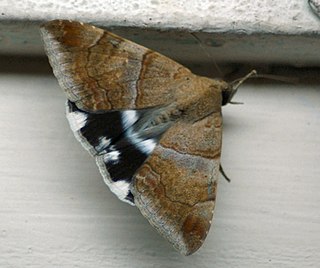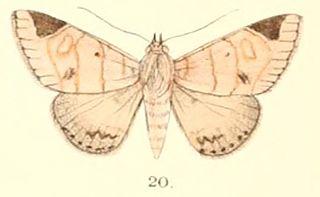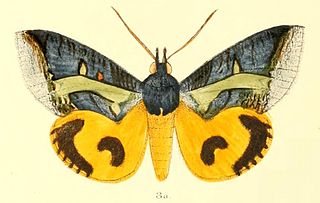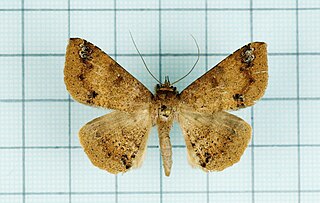
Achaea janata, the castor semi-looper or croton caterpillar, is an erebid moth, the caterpillars of which are termed 'semi-loopers' due to their mode of locomotion. It is found from the Indo-Australian tropics and subtropics, extending south to New Zealand and east through the Pacific archipelagoes to Easter Island. It is a major pest of castor throughout the world.

Dordura is a monotypic moth genus of the family Noctuidae erected by Frederic Moore in 1882. Its only species, Dordura aliena, was first described by Francis Walker in 1865. It is found in the Indian subregion, Sri Lanka, Myanmar, Thailand, Peninsular Malaysia, Sumatra, Borneo and New Guinea.

Hulodes caranea is a species of moth of the family Erebidae first described by Pieter Cramer in 1780. It is found from India, Sri Lanka, Myanmar, Java, Hong Kong to Queensland and New Guinea, it is also found on the Marianas and Carolines.

Eudocima homaena is a moth of the family Erebidae first described by Jacob Hübner in 1816. It is found in the Indian subregion, Sri Lanka, Myanmar, Taiwan, the Nicobars, Peninsular Malaysia, Borneo, the Philippines and on Christmas Island. It is a major pest on orange plants.

Probithia exclusa is a moth of the family Geometridae. It is found in the north-eastern Himalaya, Sri Lanka, the Philippines, Sulawesi and Sundaland.

Trabala vishnou, the rose-myrtle lappet moth, is a moth of the family Lasiocampidae. It is found in southern Asia, including Pakistan, India, Bangladesh, Thailand, Sri Lanka, Myanmar, Java, China, Japan, Taiwan, Hong Kong, Vietnam and Indonesia. Four subspecies are recognized.

Biston suppressaria, the tea looper, is a moth of the family Geometridae. It is found in China, India, Myanmar, Nepal, and Sri Lanka.

Ecliptopera muscicolor is a moth of the family Geometridae. It was described by Frederic Moore in 1888. It is found in India, Sri Lanka and Taiwan.

Ericeia inangulata, the sober tabby, is a moth in the family Erebidae. The species was first described by Achille Guenée in 1852. It is found in the Indo-Australian tropics of China, India, Sri Lanka, Myanmar, and the Marianas and Carolines, Fiji, Vanuatu, New Caledonia and Samoa.

Fascellina chromataria is a moth in the family Geometridae described by Francis Walker in 1860. It is found in Korea, Japan, Taiwan, China, India, Bhutan and Sri Lanka.

Gesonia obeditalis is a species of moth of the family Noctuidae first described by Francis Walker in 1859. It is found from eastern Africa, the Seychelles, the Maldives and the Oriental tropics of India, Myanmar, Sri Lanka east to the Philippines, the Sula Islands and Australia. The adult moth has brown wings with a scalloped dark brown band near the margin. The hindwings are similar in pattern to the forewings but are a paler shade of brown.

Polydesma umbricola, the monkeypod moth or large tabby, is a species of moth in the family Erebidae. The species is found in southern Europe, Africa, Asia Minor to southern Asia, of India, Sri Lanka, Maldives, the Andaman Islands, including many Indian Ocean islands, like Coëtivy Island, Aldabra, Assumption Island, Madagascar and on Hawaii.

Scopula fibulata is a moth of the family Geometridae first described by Achille Guenée in 1858. It is found in Kenya, Sri Lanka and China.
Carbia pulchrilinea is a moth in the family Geometridae. The species was first described by Francis Walker in 1866. It is found in the Indian subregion, Sri Lanka and New Guinea, as well as on Borneo, the Mentawai Islands and the Bismarck Archipelago. The species is found from lowlands to the upper montane forest zone.
Racotis boarmiaria is a species of moth of the family Geometridae described by Achille Guenée in 1857. It is found in India, Sri Lanka, Maldives, Myanmar, China, Japan, Taiwan, Indonesia, Bhutan and Malaysia.

Erygia apicalis is a moth of the family Erebidae first described by Achille Guenée in 1852. It is found from the Indo-Australian tropics of India, Sri Lanka to Japan, Australia and the Solomon Islands. The habitat consists of lowland areas, including dry heath forests and softwood plantations.

Hypopyra vespertilio is a moth of the family Erebidae first described by Johan Christian Fabricius in 1787. It is found in China, Korea, Honshu in Japan, India, Sri Lanka, Nepal, Thailand, Myanmar, Cambodia, Vietnam, Taiwan, Malaysia, the Philippines, Java, Sumatra and Sulawesi.

Hyposidra talaca, the black looper or black inch worm, is a moth of the family Geometridae. The species was first described by Francis Walker in 1860. It is found from India to Indochina, Sundaland, Sulawesi, the Philippines, Sri Lanka, the Solomon Islands, Thailand, Taiwan, New Guinea and Australia, where it has been recorded from Queensland. It is a major defoliating pest in tea plantations.
Eupterote translata is a moth in the family Eupterotidae. It was described by Charles Swinhoe in 1885. It is found in India.

Sphingomorpha chlorea, the sundowner moth, is a species of moth in the family Erebidae that is native to Africa and southern Asia. The species was first described by Pieter Cramer in 1777. It is a fruit-piercing moth and a notorious pest in orchards. The fruit is pierced while performing a vertical and rhythmic movement of the head.



















